Starting a new website is always an exciting adventure. You have spent long days deciding on your domain name, designing the layout, and carefully publishing your first few pages.
But what will happen next?
What if your website is not visible on Google?
It is like opening a brand store in the middle of a desert. You have everything inside, but no one even knows it exists.
This is where more beginners get stuck. They launch a site expecting Google to send traffic within a few weeks.
But reality is different, and they hardly get any visitors. I have been there too, when I started my first business website rajsoftechsolutions.com, years ago.
I am clueless about how search engines work, why my site is not ranking, and why Google is not noticing me.
It took me years of trial and error to figure out what really works for new websites to achieve SEO results quickly.
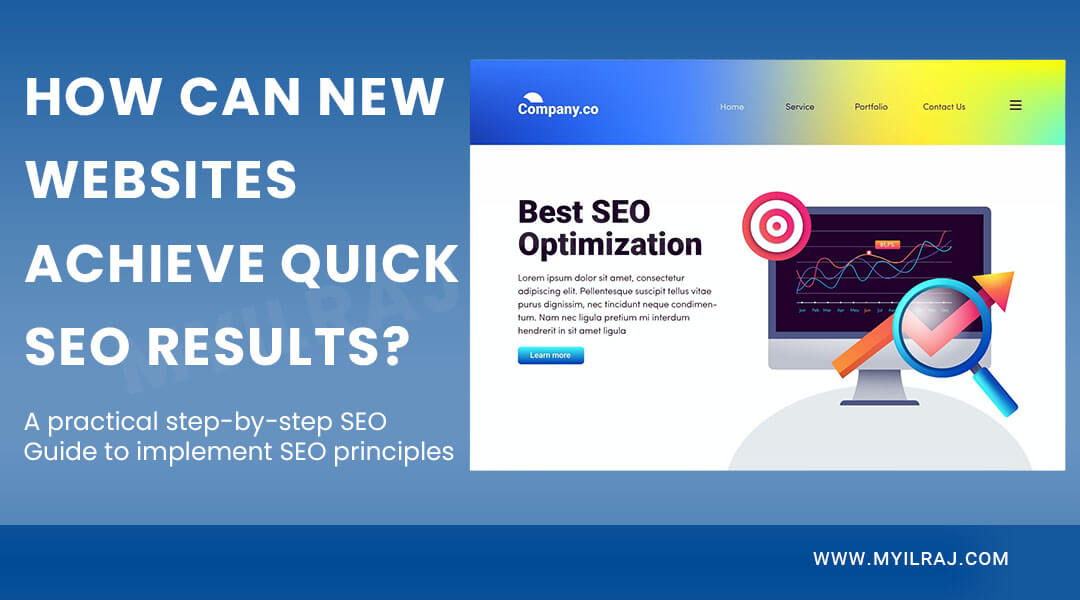
In this blog, we will walk step by step through checking SEO Strategies for New Websites:
- How to build a strong technical foundation so Google trusts your site.
- Doing keyword research in a smarter way (not the hardest part).
- Creating content for Humans, Search Engines, and AI love.
- Quick wins like backlink strategies and on-page tweaks for new websites.
By the end of this guide, you will learn how to start SEO for your new website.
And also, you will have a clear roadmap to see results faster than you imagined.
Understanding SEO for New Websites in 2025
In 2025, you don’t need to wait for months or years to see your site progress.
By implementing smart keyword targeting, a structured SEO plan, and the right technical foundation, you can get visibility in just weeks.
It was very difficult for me when I first started learning SEO.
A few years back, it was all about building backlinks and stuffing keywords. Bigger websites with more money can dominate search results.
But 2025 SEO is no longer about tricking search engines. With AI-driven search assistants like Google Gemini and ChatGPT, the way people find information has completely changed.
Today, people expect direct answers, personalized results, and lightning-fast solutions.
Your SEO strategy for a new website should not rely on old tactics anymore. Yes, you have to think beyond keywords and rankings.
More precisely, you need to focus on user experience, authority, and relevance right from the start.
What If Big Sites are Dominating My Niche?
Yes, you might be struggling with competing with big sites in your niche. My answer is to create a focused SEO strategy and start SEO for a new website with smart positioning.
- Stop targeting high-competition terms in your niche.
- Instead, aim for quick-win keywords, optimize your site structure, and build credibility step-by-step.
For every beginner in SEO, if you want to know how to rank a new website fast, stop comparing yourself to giants.
Just turn your focus on the right intent-focused keywords where you can win quickly.
To support this process, you need to find an SEO partner, whether a freelancer or an agency. Read my guide on Freelance SEO vs Agency SEO: What’s Right for Your Business in Coimbatore to make a strategic decision for a new site SEO.
Key Takeaway:
SEO today is not about chasing traffic.
It is all about crafting a smart, targeted strategy that gets you quick wins as well as long-term growth.
Step 01: Building a Strong Technical Foundation
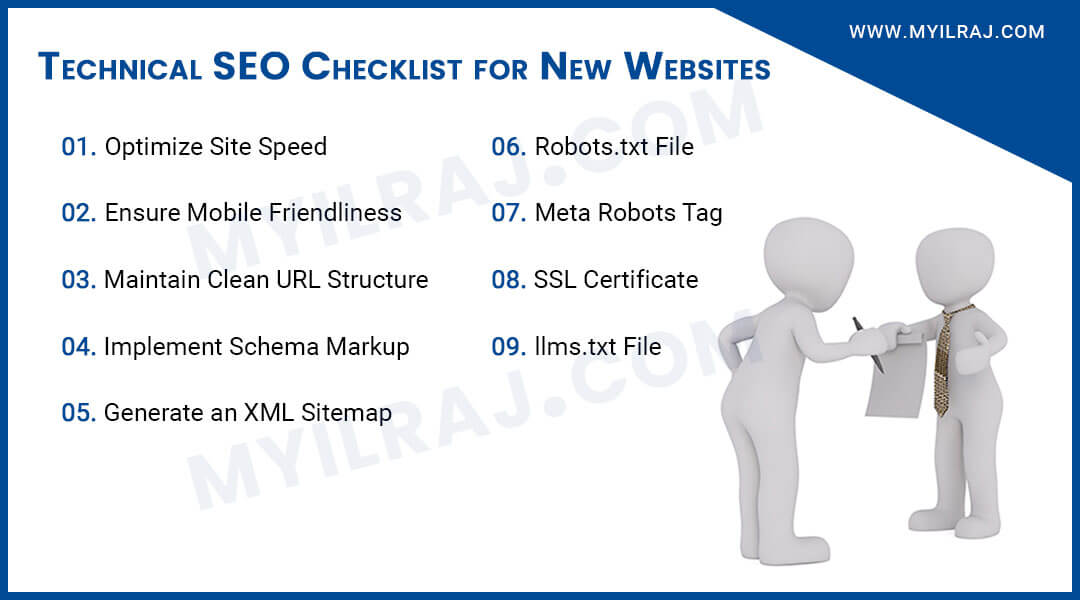
Before you start writing blogs or chasing backlinks, stop and listen to me. If your website doesn’t have a solid technical foundation, all your SEO efforts will collapse.
Just imagine you are building a new home. The design, furniture, and interior decorations are top-notch.
But if the foundation is weak, the whole structure won’t last. The same principle applies to technical SEO for new sites.
I made the same mistake of ignoring technical aspects.
My site was slow, the URLs were messy, and I had no proper sitemap.
Search engines didn’t even know my site existed for weeks. Don’t make the same mistake.
Here’s the technical SEO checklist for beginners that I personally use when developing WordPress websites for businesses.
Optimize Site Speed
- Use a lightweight WordPress theme and plugins.
- Compress images without losing quality.
- Serve images in the WebP format for lesser bandwidth consumption.
- Enable browser cache and use a reliable shared hosting service.
Make Your Website Mobile-Friendly
- More than 70% of users browse our website on mobile devices.
- Use a responsive theme to design your website.
- Test your website on Google’s mobile-friendly test tool.
- Ensure fonts, buttons, and layouts look good on all screens.
Maintain a Clean URL Structure
- Rewrite URLs using short and keyword-rich text.
- Avoid long-form URLs and special characters in the URLs.
- Avoid duplicate URLs with proper canonical tags.
E.g.
Refer to https://www.myilraj.com/seo-consultant-in-coimbatore, which clearly defines the purpose.
Avoid URLs like https://www.myilraj.com/page?id=1234, which don’t convey any meaning.
Implement Schema Markup
- Schema helps Google and AI to understand your content better.
- You can use any plugins or a manual schema generator tool (available online).
Important Schema for Blog Post
- Blogposting
- FAQ
- LocalBusiness (or) Organization (or) Person
- Breadcrumbs
- Navigation
Important Schema for Webpage
- Webpage
- FAQ
- LocalBusiness (or) Organization (or) Person
- Breadcrumbs
- Navigation
Other important schemas like review schema, rating schema, price schema, and offer schema can get you higher CTR in search results.
If you are planning to build a new website, you can just learn how much the website design costs in Coimbatore.
Important Technical SEO Elements
- Generate an XML sitemap and submit it to Google Search Console.
- Create a robots.txt file to guide crawlers.
- Implement the meta robots tag sitewide.
- Ensure an SSL certificate is installed on your domain name.
- Create a text file for LLM bots.
By creating a strong technical foundation, you are telling Google that your site is trustworthy, fast, and user-friendly.
But beyond technical SEO, local businesses require visibility strategies specific to their market.
Learn the benefits of doing SEO for your business in Coimbatore that strengthen your digital foundation in the local search ecosystem.
Key Takeaway:
Technical SEO is not a one-time job.
Conduct a technical SEO audit frequently to ensure your site is healthy and discoverable.
Step 02: Keyword Research & SEO Planning
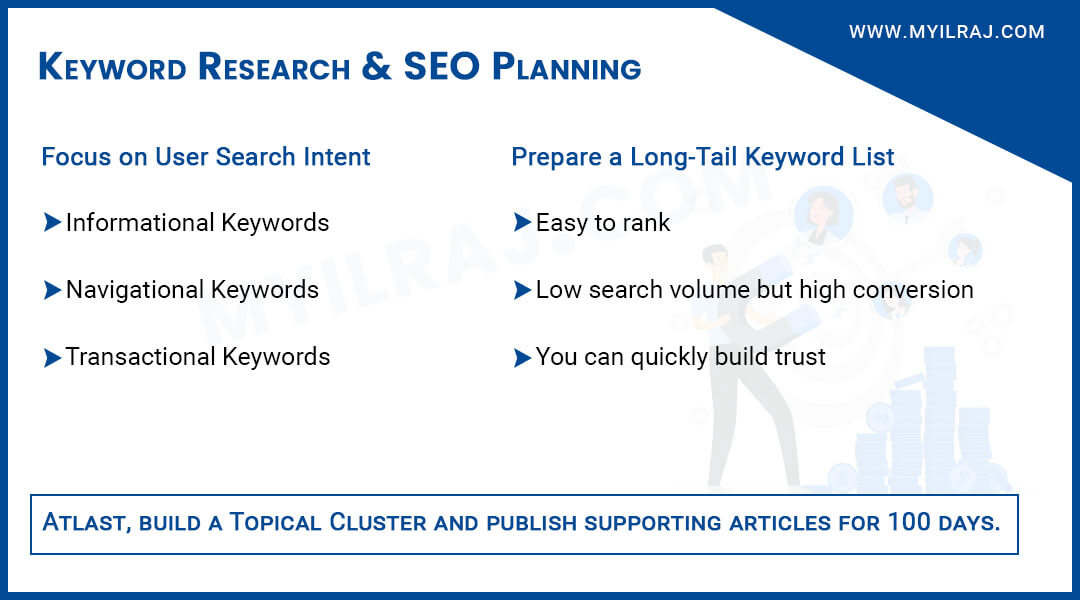
After setting up the technical foundation, start planning your SEO roadmap for the new website. I am seeing many beginners fail at this stage.
They either chase the wrong keywords or have no clear content strategy.
At first, I thought targeting high-volume keywords like SEO, blogging, digital marketing, or website designing would make me successful.
But I failed, and I learned. It’s like I am trying to outrun Usain Bolt without even learning how to jog.
That’s why I always say our SEO checklist for a new website should always start with smart keyword research.
A low-competition, intent-driven keywords that actually bring results.
Here’s how you can start.
Focus on Search Intent
So you developed a website for your digital marketing agency.
You are planning to publish a post on the topic, “Best Digital Marketing Agency in Coimbatore.”
Now, search for what the user really wants when they type this keyword?
Informational: People who look for guidance.
Navigational: People search for a brand or website.
Transactional: Ready to take your digital marketing services.
If your website is new, target informational intent keywords like “new website SEO tips” or “how to improve SEO for a new website in 30 days.”
You can easily rank, and it helps you build trust.
Prepare a list of Long-Tail Keywords (for quick wins)
Stop aiming to rank your website for the keyword “SEO company.” Instead, write articles on the following topics;
- How to do SEO for a new website step by step.
- SEO best practices for a newly launched website.
- How SEO is important for a new website.
These long-tail keywords may have a lower search volume, but they directly hit your audience’s pain points.
Build Content Clusters (Topical Clusters)
Don’t directly jump into publishing 30 blogs in 30 days and blame Google that your site is not indexed or ranked.
Create content clusters where one main article connects to other smaller related posts.
For Example,
Main Pillar Page: SEO Strategy for New Website
Supporting Blogs (you can write):
- Quick SEO tips for new websites
- On-page SEO for beginners
- Backlink strategies for new websites
Now, can you understand the clustering process?
It tells Google that you are an authority on this topic, and that helps your pages rank better.
Create a Realistic 30-day Plan
If you are wondering how to improve SEO for a new website in 30 days, here’s the plan.
Week 1: Finalize keyword research + set up Google Analytics and Search Console.
Week 2: Publish 2 optimized blog posts targeting long-tail keywords.
Week 3: Optimize on-page SEO + interlink your blog content.
Week 4: Build 3 to 5 quality backlinks (a combination of guest posts, profile links, niche directories, or collaborations).
In the end, keyword research should not be about chasing just search volume.
Your research must align with real user needs. If you get this step right, your content will naturally attract the right audience.
Step 03: Creating High-Quality, Optimized Content
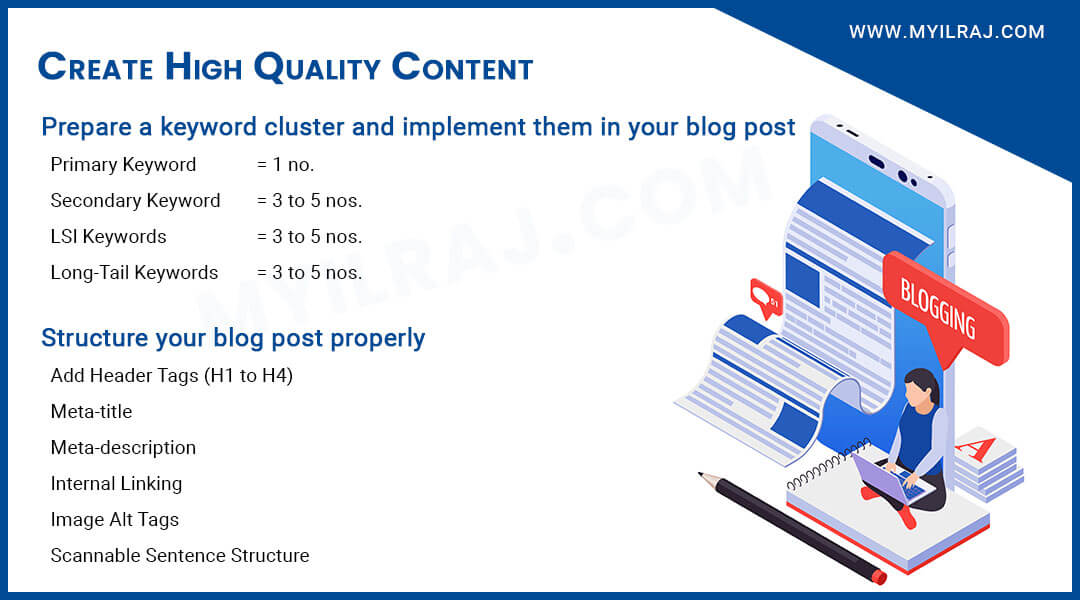
Content and Keywords are the real game-changers in SEO. I have learned this in my 10+ years of blogging and SEO.
Usually, a new website may not have backlinks or authority. But when you publish content that is practical, optimized, and solves real user problems, Google will notice it.
Create a Content Strategy with a Calendar
Whenever I start SEO for a new website, I always start by creating a content calendar.
Because random posting will not work in 2025. Every article must have;
A primary keyword (e.g,. SEO for new websites)
A few secondary keywords (like new website SEO tips, new site SEO)
LSI and Long-Tail keywords (Such as how do you learn SEO for a new website blog).
By implementing this practice, your content cluster will improve. Content clusters make it easier for search engines and AI to understand your authority.
Optimize Your Content (On-Page SEO for Beginners)
The next step after you write content is structuring it by implementing proper on-page SEO.
Let me simplify it;
Add Headings (H1 to H4)
Create Meta Tags
Internal Linking
Image Optimization
These basics may look simple, but trust me, 80% of new websites ignore them.
Why SEO is important for a new website? Even if you don’t have a social media presence, a well-optimized blog post can bring in visitors daily.
Step 04: Backlink Building & Authority Creation
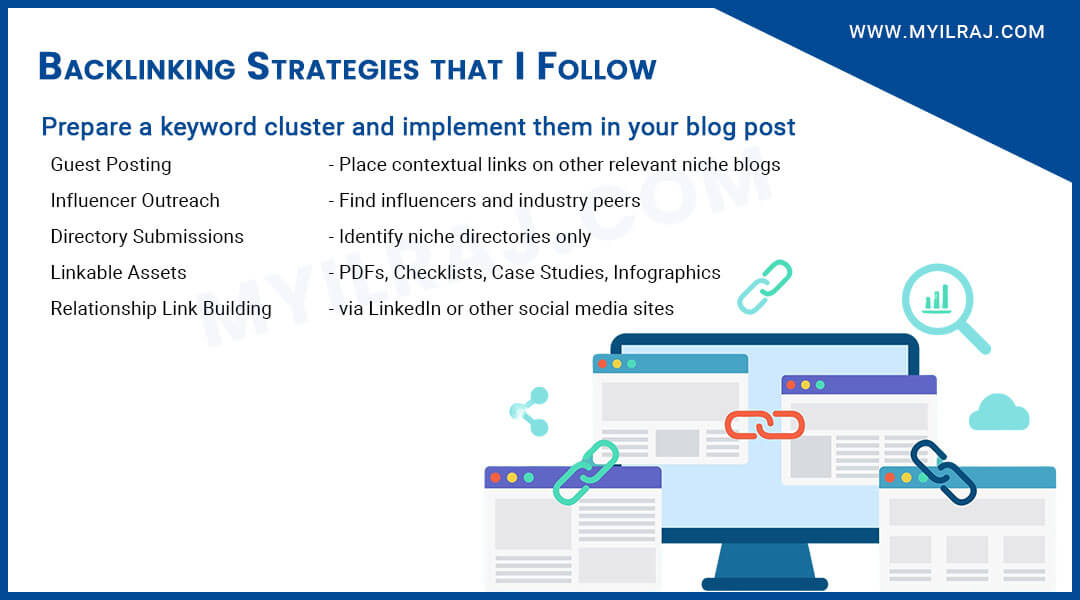
Almost every week, I get this question from new website owners. Do I really need backlinks to rank? My answer is yes, but only relevant backlinks matter.
Every backlink is a vote of trust for your website. When another site links to your website, it says, Hey, this content is useful.
Search engines and AI endorse this value, especially if your website is new.
Among the 100s of ranking signals, backlinks remain the strongest one.
A website with high-quality, relevant links often outranks one with none.
Even though you publish valuable content, if you don’t have a smart backlink strategy, you will not rank easily.
Proven Backlink Strategies for New Sites:
Here’s what I recommend for new website owners for building backlinks;
Guest Posting: Reach out to relevant blogs and websites in your niche. Ask for a chance to publish a blog post, and in return, you will earn a contextual backlink.
Influencer Outreach: Share your blogs with influencers or thought leaders in your niche. Sometimes, a single mention will drive you thousands of traffic and authority.
Directory Submissions: Submit your website to niche-specific or local directories, but not spammy ones. A directory listing can help your site index faster and attract referral traffic.
Linkable Assets: Repurpose your blog posts into checklists, templates, case studies, or PDFs. People naturally link to content when they feel it’s helpful.
Relationship Link Building: Start building a social relationship with peers in your niche and contribute to their growth. In return, you can ask for a backlink from their website or blog.
Does your new website need expert help in building authority?
Are you stuck with finding the right SEO person?
Learn more about choosing the best SEO consultant for your business to avoid costly mistakes and generate long-term revenue.
Quick SEO Tips for Immediate Impact
So far, you have launched your website and done all technical setups. Moreover, you have written a few blog posts and are awaiting Google to index them.
But in reality, SEO takes time, but there are some quick actions that give your new website a visible boost in a shorter time.
Let me share those steps below;
Optimize Meta Tags and Implement Schema
Your Meta-title and Meta-description are the first things users will see on Google. Make them creative, descriptive, and keyword-rich.
Implement Schema markup for blogs, articles, products, or services to help AI and search engines discover your content easily.
Submit Your Sitemap to Google Search Console
Generate an XML sitemap and submit it to Google Search Console. It makes Google crawl your site quickly.
I recommend checking the indexing status every two days, especially during the first 30 days after launch.
Leverage Social Signals by Sharing Your Post
Create social media profiles and share your content on LinkedIn, Facebook, Instagram, and niche forums.
Even small social traction can drive quick traffic and get your pages noticed by search engines.
It is not about creating content; you must make sure Google sees it, understands it, and users actually click on it.
By following these quick SEO tips for your new websites, you will see faster traction.
Measuring Your New Website SEO Performance

So you have launched your website and optimized it as per the SEO standards. But the actual growth will happen only when you track results and refine the strategy.
Essential Tools I Use
To track SEO performance, I use;
- Google Search Console to track indexing status, CTR, keyword position, and search queries.
- Google Analytics to understand user behavior, traffic sources, and user engagement.
- SEMrush or Ahrefs to monitor keyword rankings, competitor analysis, and backlink tracking.
Important Metrics to Monitor
There are a number of vanity metrics, but focus on these metrics only for continued growth.
- Organic Traffic
- New Users and Repeated Users
- Keyword Rankings
- Click-Through Rate
- Impressions
- Search Queries
- Bounce Rate and Engagement
- Backlink Sources
Remember, SEO for new websites is never a “set and forget” kind of thing.
It is a continuous process where you must measure, tweak, and repeat the process to turn your new website into a reliable traffic source.
Also, don’t miss discovering how to check if SEO is done on your website with my step-by-step audit process.
At Last, Future-Proof Your SEO For New Websites
Remember one thing, SEO isn’t static. What works today might not work tomorrow. During my initial days, I wrote content stuffed with keywords.
But those old-school SEO strategies will make your site invisible. Therefore, along with implementing basics, you also need to future-proof your SEO.
Nowadays, all search engines have turned to an AI-driven mechanism. AI can save you time, uncover trends quickly, and even predict what your audience wants next.
Therefore, use AI tools for keyword research and the content creation process, but remember that readers value authenticity.
- Keep learning the latest SEO trends and AI influence. Keep your website updated.
- Don’t just focus on ranking and driving traffic. Always focus on building a brand that people can trust.
- Engage with your audience, share case studies, insights, and experiences publicly.
- Authority is not built overnight; it will be earned consistently.
Even if your new website gains traffic early, the real win is sustainable growth.
Final Thought from Me (Myilraj. G)
Starting SEO for a new website seems to be overwhelming. But if you focus on these four areas that I explained in this article, you can achieve remarkable results.
A strong technical foundation, smart content strategy, backlinks, and continuous improvements are the foundation.
SEO is a journey, and I recommend starting it with the right steps and staying consistent. I promise that you will grow into an authority in your niche.
What You Should Do Next?
If you want to fast-track your results and avoid common pitfalls, let me tell you what to do.
Take my SEO Consulting Services, where I will personally audit your website and create a unique SEO roadmap.
Redesign Your Website on WordPress and ensure that the design is optimized for SEO and higher rankings.
Don’t wait for the right time, as your competitors are already ahead of you.
